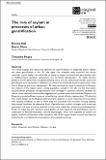Files in this item
The role of asylum in processes of urban gentrification
Item metadata
| dc.contributor.author | Hill, Emma | |
| dc.contributor.author | Meer, Nasar | |
| dc.contributor.author | Peace, Timothy | |
| dc.date.accessioned | 2021-08-19T10:30:03Z | |
| dc.date.available | 2021-08-19T10:30:03Z | |
| dc.date.issued | 2021-03-01 | |
| dc.identifier | 275502383 | |
| dc.identifier | 081abc5e-ba29-4264-9ebe-9dc18eac02d9 | |
| dc.identifier | 85099848642 | |
| dc.identifier.citation | Hill , E , Meer , N & Peace , T 2021 , ' The role of asylum in processes of urban gentrification ' , The Sociological Review , vol. 69 , no. 2 , pp. 259-276 . https://doi.org/10.1177/0038026120970359 | en |
| dc.identifier.issn | 0038-0261 | |
| dc.identifier.uri | https://hdl.handle.net/10023/23798 | |
| dc.description | This research has been funded by the Economic and Social Research Council, project reference ES/R00451X/1. | en |
| dc.description.abstract | This article analyses the relationship between the accommodation of Dispersed asylum seekers and urban gentrification in the UK. We argue that alongside other racialised and classed minorities, asylum seekers are vulnerable to spatial strategies associated with gentrification such as neighbourhood ‘dumping’, containment and ‘territorial stigmatisation’, the highly coercive quality of the UK government’s Dispersal Scheme means that any relationship between asylum and gentrification must be treated as deliberate, the result of the multiscalar interests which have a stake both in Dispersal and urban ‘development’. Drawing on empirical research conducted in Glasgow, the recipient of the largest asylum seeking population annually in the UK, we find that asylum accommodation processes and gentrification have developed a symbiotic dynamic, whereby the ‘failure’ of mid twentieth-century urban ‘regeneration’ provided means and motive for Dispersal, and Dispersal provided sufficient resources to fuel further rounds of urban ‘regeneration’. We also find that recent changes to the Dispersal contract, from a dynamic in which resources were associated with housing availability, to one in which they are associated with maximum housing capacity, have created conditions for alternative forms of gentrification, in which strategies such as rent gap suppression are seen as having potential to yield more capital than infrastructural development. Finally, we argue that the respective spatial politics of both Dispersal and gentrification must be understood as mutually-interested, coercive technologies, which work together to contain and exploit racialised and bordered urban minorities. We call for urgent further research into how the asylum border is embedded in contemporary urban spatial economies. | |
| dc.format.extent | 18 | |
| dc.format.extent | 127043 | |
| dc.language.iso | eng | |
| dc.relation.ispartof | The Sociological Review | en |
| dc.subject | Asylum | en |
| dc.subject | Dispersal | en |
| dc.subject | Gentrification | en |
| dc.subject | Glasgow | en |
| dc.subject | Rent gap | en |
| dc.subject | H Social Sciences (General) | en |
| dc.subject | NDAS | en |
| dc.subject | SDG 9 - Industry, Innovation, and Infrastructure | en |
| dc.subject | SDG 11 - Sustainable Cities and Communities | en |
| dc.subject.lcc | H1 | en |
| dc.title | The role of asylum in processes of urban gentrification | en |
| dc.type | Journal article | en |
| dc.contributor.institution | University of St Andrews. School of Geography & Sustainable Development | en |
| dc.identifier.doi | https://doi.org/10.1177/0038026120970359 | |
| dc.description.status | Peer reviewed | en |
This item appears in the following Collection(s)
Items in the St Andrews Research Repository are protected by copyright, with all rights reserved, unless otherwise indicated.

